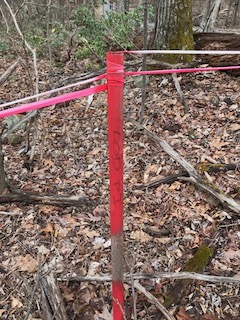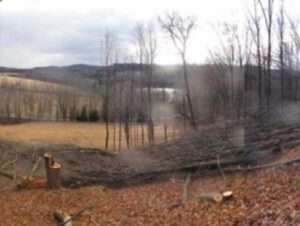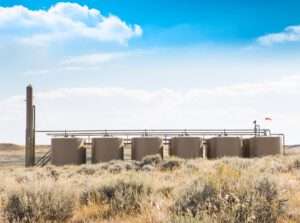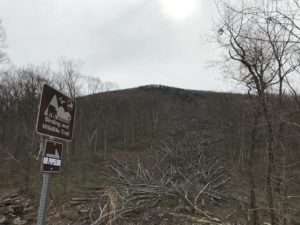
With its permitting authority over natural gas infrastructure, the little-known Federal Energy Regulatory Commission has sweeping power over individual citizens’ property and our collective climate trajectory. Critics say that reforming its pipeline review process should be high on President Joe Biden’s agenda.
On March 1, 2016, Megan Holleran and her family watched as federal marshals, clad in tactical vests and clutching semiautomatic weapons, escorted a crew of chainsaw-toting contractors onto their wooded property in New Milford, Pennsylvania.
The Hollerans took care to stand at least 150 feet away – the buffer distance mandated by a federal judge, on penalty of steep fines – from the swath of their land that the judge had awarded to energy companies behind the Constitution Pipeline, a planned 124-mile-long project to transport natural gas from the fracking wells of the Marcellus Shale to Albany, New York and beyond.
The Hollerans were placed in this peculiar bind – effectively prohibited from trespassing on their own land – by a ruling of the Federal Energy Regulatory Commission (FERC), an obscure agency with a sweeping mandate.

FERC has ultimate authority for approving interstate oil and gas pipelines. In December 2014, FERC granted a “certificate of public convenience and necessity” to the Constitution Pipeline. With it came the power of eminent domain, the power to seize private land for infrastructure that is purportedly in the “public interest.”
Normally in early March, the Hollerans would start boiling sap from their trees to make syrup sold by their family business, North Harford Maple. Instead, they watched the contractors cut down 90 percent of their productive maples.
After four days of felling to clear a path for the 30-inch steel pipe, more than 500 mature trees lay in a tangle on the ground. Some were more than 200 years old.
“When the trees came down, that was the ultimate feeling of being powerless,” says Megan Holleran.
The Constitution Pipeline was never built. New York state regulators denied it a key water quality certificate. After lengthy court battles over that and other necessary permits, the William Companies, an Oklahoma-based energy conglomerate that was primary owner of the project, finally abandoned it in February 2020.
The project’s owners wrote off more than $350 million in sunk costs, and moved on. But the Hollerans were left to make sense of a bewildering process that had seized their land, devastated their small business, generated hundreds of hours of worry and work, cost them thousands of dollars in legal costs – all for a project owned by investor-owned corporations that never even came to pass.
As an archaeologist, Megan Holleran has worked for firms that contract with pipeline companies. “I’m familiar with that whole industry,” Holleran, 34, says. But, like most people, she didn’t know much about FERC or its function, until she learned that the pipeline would be routed through her family’s land.
After the tree-fellers and marshals departed, orange and pink flagging was left hanging from trees and stakes in the ground, indicating the 125-foot-wide right-of-way that the Williams Companies had seized.

In the pipeline business, surveyors place those stakes along the edge of the right-of-way to mark out the “LOD”, which stands for the “limits of disturbance.” In the legal world, “LOD” is a term of art used to mark the point beyond which no construction activity is permitted.
Those stakes marked “LOD” are, in a sense, the visual expression of FERC’s governing philosophy. Within those lines, FERC effectively deems whatever disturbance that takes place – lost sugar maples, agricultural crops, depressed home values, local air or water pollution – worth the envisioned economic benefits to the wider public.
In the physical world, disturbance is not so easily contained. But the damage that takes place outside those lines is not visible to this powerful agency. Or, to be more precise, it often chooses not to see it.
“No one really realizes the impact an agency like (FERC) can have on their lives,” Holleran says.
Rubberstamp or Guardian?
FERC may be the most powerful government agency that most Americans have never heard of, and in more ways than one. It has the authority to greenlight huge infrastructure projects, from high-voltage transmission lines to pipelines to liquefied natural gas export terminals. Thanks to their power of eminent domain, some of those projects can upend individual lives and businesses like the Hollerans.’ And, thanks to operating lifespans as long as 80 years, they also shape the trajectory of the climate we all share.
Any company that wants to build a long-distance natural gas pipeline in the U.S. must receive a certificate of “public convenience and necessity” from FERC. That gives the five Senate-confirmed commissioners who make up FERC’s voting membership enormous sway over a major chunk of U.S. greenhouse gas emissions.
“FERC has a huge amount of power that will be really important as we go about transitioning” to a low-carbon energy system, said Romany Webb, a research scholar at Columbia Law School and senior fellow at the Sabin Center for Climate Change Law.
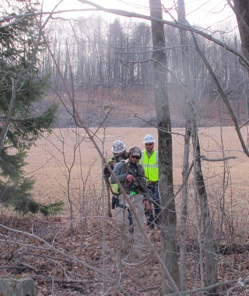
“This sleepy agency that only the most inner circle of energy nerds used to know about will become front and center,” says Gillian Giannetti, an attorney with the Natural Resources Defense Council who specializes in energy regulatory issues.
Despite the obscure and technical nature of the commission’s deliberations, the stakes are high. Energy policy experts see FERC as one of President-Elect Joe Biden’s key tools for climate action.
“FERC’s role in advancing climate policy and transitioning to a decarbonized economy has been very under-recognized really across the board,” says Webb. “They have a huge opportunity to advance the Biden’s administration’s climate goals.”
In practice, however, FERC rarely considers the full scope of potential climate change impacts when it decides whether a gas pipeline should be built.
“The problem arises when FERC downplays – or ignores entirely – one of the most significant environmental impacts of building major gas infrastructure projects: its impact on climate change,” says Mark Sabath, a senior attorney at the Southern Environmental Law Center, who has led litigation challenging FERC certificates for natural gas pipelines. “Considering both the urgency of the climate crisis and the relative ease of doing what FERC (has) claimed it was unable to do – provide some estimate of the amount of damage associated with the incremental increase in emissions – FERC’s intransigence in this area is inexplicable.”
Pipeline construction has been booming since 2005, when new fracking technology began to exploit previously untapped pockets of gas in areas like the Marcellus Shale. Critics says that FERC’s role amidst this boom has been more of a rubber stamp for the gas industry than as a guardian for the public interest, which is how federal courts have consistently interpreted its mandate under the Natural Gas Act.
Since 1999, when FERC adopted the policy that it still uses today to guide its gas pipeline review process, the agency has approved 474 projects, totaling more than 23,700 miles of pipeline around the country.
It has rejected only two.
“Unfortunately, FERC has been operating more as a pipeline processor than a pipeline reviewer,” says Giannetti. “Pipeline companies don’t start the process with the question of if they’ll be approved, but only a question of when.”
This FERC-approved pipeline building spree has swollen the ranks of angry victims of eminent domain, who believe that the commission ignores their concerns. The agency is now under mounting pressure to make it easier for affected landowners to participate in its review process, and to overhaul its approach to assessing projects’ contributions to climate change.
On December 9th, members of the House Subcommittee on Civil Rights and Civil Liberties grilled senior FERC staff about its handling of eminent domain and landowner concerns. In response to sharp questioning from Rep. Rashida Tlaib (D-MI) on why the commission refers landowners to the pipeline companies instead of reaching out itself to help them navigate the complex process, acting FERC general counsel David Morenoff noted that it has a hotline that landowners can call.
“Landowners who do call the hotline feel like they are speaking into the void,” replied Rep. Jimmy Gomez (D-CA) “It’s not your job just to authorize natural gas pipelines but to determine if it’s in the best interest of the landowners.”
FERC has never rejected a project application on the basis of its projected climate-warming emissions. But, with rising public concern about accelerating climate impacts and growing scrutiny from lawmakers, it’s becoming increasingly untenable for FERC to pretend that these projects don’t have a wider impact, that the “limits of disturbance” end at the imaginary line marked out by those stakes on the Hollerans’ land.
Downstream Denial
In recent years, Republican-appointed commissioners – who form a majority of FERC’s voting members – have consistently maintained that it’s not their job to worry about the carbon dioxide and methane emitted “upstream” of a pipeline by drillers who supply it, or “downstream” by the customers who burn it. They only take into account the relatively small amount of emissions produced during construction of the project.
Critics like Giannetti, Sabath and Webb say FERC’s approach ignores the plain fact that a pipeline will inevitably result in more gas being extracted and combusted. Indeed, increasing customer use of natural gas – along with making money for its owners – is the whole point of building a pipeline.
The vast majority of a pipeline’s emissions come from that downstream combustion in power plants, furnaces and water heaters. According to the Energy Information Administration, in 2017 more than 97% of natural gas consumed in the U.S. was burned in one way or another. (A small fraction of natural gas is used in industrial processes, or to make fertilizer.) If those emissions don’t even show up on the cost-benefit ledger in FERC’s analysis of a pipeline, the scales inevitably are tipped toward a rosier picture of its net effect on the public interest.
Some of the most pointed criticisms of FERC’s failure to fully account for climate impacts come from its own members. Current commissioner Richard Glick has dissented on several pipeline approvals in recent years, explicitly citing FERC’s failure to consider those projects’ potential contribution to climate change.
Cheryl LaFleur served as a FERC commissioner from 2010 to 2019, including serving as chair for almost four of those years. In the latter years of her tenure, LaFleur became an outspoken advocate for revamping FERC’s approach to considering emissions of greenhouse gases from pipelines.
“Since 2018, FERC has done less and less (on climate) rather than more,” LaFleur tells me. “It should do more.”
But early in her tenure, LaFleur had a very different perspective. In late 2014, activists pressed FERC to consider pipelines’ downstream emissions and impacts on climate change. LaFleur, who was then chair, rejected their charge. She argued that it wasn’t FERC’s responsibility to tally up those negative effects, but that of an environmental regulator like the Environmental Protection Agency.
For the next few years, LaFleur ruled in favor of granting certificates to many gas pipeline projects, without voicing concerns about their impacts on climate change.
“I’ve been very honest that there was definitely an evolution” in her approach to considering the climate impacts of pipelines, LaFleur says.
“When I first got to FERC it was explained to me that the standard was: we only look at the environmental consequences of construction itself, of building the pipeline, and not upstream when they fracked the gas or downstream when they burned the gas. That seemed sensible enough to me. That’s how it was done for a long time. And at that time gas was seen as the environmental savior.”
This was early in the Obama era, and natural gas was widely touted as a climate solution, one that would replace dirtier coal as a power-generating fuel.
“We saw a lot of pipelines going in new places because of new shale plays, with a lot of opposition,” LaFleur says. Over time, as more pipeline applications came in, and more and more members of the broader public weighed in, her thinking changed. “I became uncomfortable with way FERC was looking at [the] need for pipelines.”
When LaFleur and three other commissioners issued a certificate of approval for the Constitution Pipeline in December 2014, the accompanying Environmental Impact Statement (required by the National Environmental Policy Act as part of its review) did not quantify upstream or downstream emissions. It noted that the project would make a “small contribution” to global greenhouse gas emissions and that there is “no standard methodology to determine how” those emissions “would translate into physical effects on the global environment.”
That particular phrasing appears again and again in FERC’s pipeline approvals over the past decade. The rulings occasionally estimate a project’s direct construction-related emissions, but they consistently state that FERC doesn’t have the authority or even the ability to quantify the “significance” of those emissions – the extent to which it contributes to climate change and its onslaught of drought, storms, heatwaves and floods.
“They’ll say ‘We have no test or means to analyze the significance of that number’ and move on,” says Giannetti.
She calls FERC’s current approach to considering climate impacts a “shell game,” and notes that federal agencies make such judgments all the time, using well-honed methodologies such as the “social cost of carbon” to assess how much damage a given ton of carbon dioxide might wreak.
LaFleur says her own thinking on the downstream question shifted while working on a pipeline review in 2016. The majority of the commissioners insisted they couldn’t look at downstream emissions, but went into great detail cataloging downstream economic benefits that demonstrated why the project was needed. “I said, ‘Why can’t we look downstream if we’re doing that?’ I thought something is unraveling here.”
“More and more people came in our dockets and asked us to look downstream,” says LaFleur. And then came a federal court decision on the Sabal Trail pipeline in Florida in 2017, which explicitly ordered FERC to consider downstream emissions in more detail.
But FERC’s Republican-appointed majority effectively swatted it away. In May 2018, the commission voted 3 to 2 to no longer include estimates of those downstream emissions in its environmental impact reviews, because they were “inherently speculative.” They reasoned that, if FERC couldn’t be completely certain of where and how the gas delivered by a pipeline was going to be used, they would have to simply ignore the resulting emissions.
LaFleur says she “strongly disagreed” with that move. In the very next ruling, approving a pipeline in Tennessee, LaFleur pushed back by including her own back-of-the-envelope calculation of the project’s likely impact on both upstream and downstream emissions, just to demonstrate how easy it was.
“FERC says, ‘We don’t know where the gas is going, so we can’t calculate downstream emissions,” says Romany Webb. “That’s such a cop out to say that. It’s well within their ability, they just choose not to do it.”
Giannetti agrees, calling FERC’s willful blindness to those downstream emissions “intellectually dishonest.”
“If one commissioner can do it, I have full faith that the full brain trust of statisticians and climatologists available to FERC can develop a test that works for this.”
“The Public Convenience and Necessity”
FERC has a long history of such foot-dragging or indifference to both court orders and legislative directives.
In 1978, Congress passed the Public Utility Regulatory Policy Act. It ordered FERC to set up the Office of Public Participation. Since then, members of both the House and Senate have put forward bills requiring FERC to staff this internal office, which would expand access to information and advocate for members of the public in the agency’s decision-making process. For more than 40 years, FERC has never taken steps to create the office.
Around the same time that LaFleur was having her awakening to pipelines’ climate impacts, Megan Holleran was receiving a hard education in how FERC measures what’s in the public’s interest and who gets to participate in that process.
“When we started out, I thought, here’s how eminent domain works: they can’t use it unless the pipeline is for the public interest,” she recalls. “I thought that if we followed the rules, we had the facts on our side, we would win.”
A few weeks after her maples were felled, on March 24th, 2016, Holleran traveled to Washington, D.C. Along with several other protestors, she set up a pancake-cooking station on the sidewalk in front of FERC’s main office. Holleran served up syrup from her family’s operation and invited FERC commissioners and staff to leave their offices and come sit down over some pancakes to talk about how their rulings affected landowners like her, and how they affected climate change.
No one came down. So Holleran and her companions sat in front of the building’s entrance, refusing to leave until they were arrested by Homeland Security agents.
The family persisted. In 2019, Catherine Holleran, Megan’s mother and a co-owner of North Harford Maple, traveled to Washington twice to meet face-to-face with commissioners –including LaFleur – and share her experience. She asked if they thought what happened to her family made any sense. “Of course they don’t really respond,” says Megan. “That’s part of the problem: most of them aren’t thinking ‘These are people, and this is what happened because of our decision’.”
The U.S. Constitution sets a high bar for the exercise of eminent domain: taking land for an infrastructure project is justified only when it is in the public interest.
“Then you find out that’s not really how it works,” says Holleran. “In the case of gas and oil infrastructure, they don’t really need to prove it’s in the public interest. That’s a pretty serious problem.”
Experts agree that the Natural Gas Act couldn’t function without the use of eminent domain. Some land must be confiscated to bring valuable commodities to market across state lines. But the hard question is where to set the bar. At what point is that value exceeded by the damage to those in the path, and the rest of us living downstream?
Answering that difficult question, in essence, is FERC’s central job.
When a company like Williams wants to build a natural gas pipeline, the document it seeks from FERC is a “certificate of public convenience and necessity.” That language comes from the Natural Gas Act, the federal law passed in 1938 to regulate the price of gas shipped and sold across state lines. The NGA stipulates that FERC may approve a pipeline only if it “is or will be required by the present or future public convenience and necessity; otherwise such application shall be denied.”
The law further directs FERC to “evaluate all factors bearing on the public interest,” and to approve a project only if the benefits to the public outweigh its adverse effects, including environmental effects.
In practice, however, FERC seems to approve a project on the basis of just one criterion: whether the pipeline developer presents signed contracts with a shipper. A shipper is an entity that wants to buy some of the capacity on the new gas line. When a firm like Williams comes to FERC with these “precedent agreements” – some of which may only be for 10 or 15 years in duration – the commission accepts them as adequate evidence of economic demand for the project.
“Making someone give up private property is an incredible burden you’re placing on that person,” says Giannetti of NRDC. “Looking at the greater public interest balancing that FERC does, it’s certainly relevant to ask whether it makes sense to take the land of private property owners forever, for a project that will be overtaken by other market factors in a decade.”
Susan Tierney is a former assistant secretary of the Department of Energy, and currently an energy and utility policy expert with the Analysis Group, a consulting firm in Denver. She has argued that FERC isn’t doing what the law demands of it: considering all relevant factors.
In an extensive 2019 analysis of all of FERC’s pipeline approvals since 1999, she found that the agency effectively treats precedent agreements as the only relevant factor in determining the need for a pipeline.
Surveyors’ stakes marked LOD for “limits of disturbance” at the edge of a natural gas pipeline right-of-way. Credit: Jonathan Mingle
“FERC’s near-exclusive reliance on these agreements undervalues the many other factors — such as demand forecasts, availability of capacity on other pipelines, impacts on landowners and local communities, states’ energy and environmental policies, and the findings from the agency’s own environmental reviews — that are relevant when reviewing whether a particular pipeline is needed to serve the public interest,” Tierney wrote.
In a 2019 paper, Romany Webb analyzed 125 pipelines approved by FERC between 2014 and 2018. Her findings bolster Tierney’s case. She found that only five of those decisions even mentioned environmental concerns in the section outlining its reasons for approving the project.
“The impression you get from reading a lot of their decisions,” Webb says, “is that economics trumps everything else. If the operator can demonstrate need in the form of precedent agreements, “then that equals ‘public interest’, and therefore the pipeline will be approved.”
Webb, a veteran observer of the pipeline regulatory process, wasn’t surprised to see this heavy weighting on economic considerations. What did surprise her “was just how cursory the analysis of climate impacts in those statements is.”
“It’s really concerning to look through those documents and see that they are often not considering upstream and downstream emissions,” she says, “and if they are considered, then they are dismissed on the basis that it’s just a tiny fraction of global emissions – which is true of almost every individual project.”
By that logic, Webb wryly adds, one would never do anything about climate change.
There are signs that FERC’s insistence that it has no role to play in addressing the urgent threat of climate change may not survive 2021.
In December, in a rare instance of bipartisan action, the U.S. Senate approved the nomination of two new FERC commissioners, after more than two years without the full slate of five. Veteran energy lawyer Alison Clements will fill LaFLeur’s seat, which has been vacant since June 2019. In June, another seat will become vacant, when GOP-appointed commissioner Neil Chatterjee’s term expires.
Before then, President Biden will also have the power to appoint the chair, who can steer the agency’s focus through control of staffing, resources and agendas. Many speculate that he will replace James Danly, the current chair, with Richard Glick.
“The chair sets the agenda for what the commission works on,” says Webb.
For instance, FERC opened an official inquiry in April 2018 into whether it should make changes to that process. It received a tsunami of input, more than 1,600 public comments, but the commission has taken no steps on the issue ever since. “As chair Glick could prioritize review of the pipeline certification rules, and take that forward,” says Webb.
Meanwhile, the recent omnibus bill passed by Congress requires FERC to submit a plan within 180 days to finally establish the long-awaited Office of Public Participation. The office will ensure “that consumers, landowners, & others that can’t afford expensive legal representation can participate effectively in complex FERC proceedings that have significant impacts on their lives,” Glick tweeted on Dec. 27, the day it was finally signed by President Donald Trump.
Whether lawmakers might have an appetite for a deeper overhaul of the Natural Gas Act is an open question. When the law was passed in 1938, legislators were concerned that gas companies were effective monopolies, and could hike prices as high as they wanted. The other goal of the act was to ensure that heavily populated cities in the North and Midwest could have access to natural gas produced in the Gulf Coast region.
Times, to put it mildly, have changed. A glut of natural gas from fracking in the Marcellus and Permian Basins has cratered prices. The pipeline building gold rush of the past decade has disturbed individual landowners and our climate to a degree that is far from trivial.
LaFleur and Holleran would like to see Congress act to reflect this new reality.
“The Natural Gas Act could use some tweaking,” says Holleran, who says she doesn’t oppose all gas infrastructure. “We’re in a different world now than when it was written.”
LaFleur notes that the U.S. House energy committee has been looking at legislation that would specifically mandate that FERC consider and quantify the full spectrum of greenhouse gas emissions from projects it approves. “That would be salutary,” she says. “But my view is that FERC already has not only the authority but the responsibility to consider downstream emissions.”
Indeed, it would be enough, according to experts like Webb and Giannetti, if FERC just applied its existing authority to regulate gas transmission, and weighed the public interest in a more rigorous and balanced way.
Webb argues that Section 7 of the Natural Gas Act gives FERC all the authority it needs to consider a project’s contribution to climate change when it weighs whether a pipeline is in the public interest. And FERC’s own history of considering downstream environmental impacts supports this view, she adds. In earlier decisions, FERC examined whether a new pipeline might replace coal-fired electricity generation with gas-fired power, and tallied up the air quality benefits that would result. “My paper argues they should do that same thing, but looking at the potential negatives of natural gas.”
“Just follow the law as required,” says Giannetti. “The current policy statement as written is pretty good. It just needs to be followed.”
Four years later, Megan Holleran remains committed to pushing for reform of FERC.
After the Constitution Pipeline was cancelled in February 2020, the Holleran family finally reached a settlement this past summer with the Williams Companies for the damage to their land.
With the help of a nonprofit conservation group, the Hollerans recently planted 200 red oaks, sugar maples and red maples among the giant stumps that were left, and never removed, by the Constitution pipeline contractors.
The saplings will take at least 40 years to grow big enough to be tapped for sap. But they represent some kind of hope: the next generation of the family might one day turn that sap into syrup.
“The right-of-way looks a lot better,” says Holleran. “A month ago, we planted a couple hundred new saplings. It’s all grass and brush, but hopefully be able to keep clear and they’ll start growing.”
The settlement terms prevent her from speaking about the Constitution project and past litigation, but Holleran continues to be outspoken about what she regards as FERC’s ongoing failure to listen to the concerns of citizens affected by its decisions.
“We’re trying to contribute our experience,” she says, “so it gets used as an example.” She has participated in public forums and conducted outreach, trying to make more of her fellow citizens aware of FERC’s immense powers, and the need to hold it accountable. It is, she says, her attempt to make all the damage worth something, to salvage it in some way.
The question she wants people to ask, when they look at what happened to her family is: “Does anyone think, after it’s all over, that this is the way it should have worked?”
Jonathan Mingle is examining the future of natural gas during his APF fellowship.

